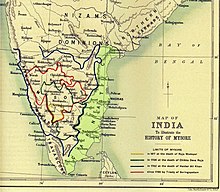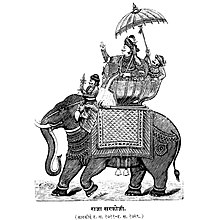Nizam's Carnatic campaigns (1725-27)
| Nizam's Carnatic campaigns (1725-27) | |||||||
|---|---|---|---|---|---|---|---|
| Part of Maratha–Nizam War | |||||||
 Carnatic region | |||||||
| |||||||
| Belligerents | |||||||
|
|
| ||||||
| Commanders and leaders | |||||||
| Tulaji |
Iwaz Khan | ||||||
| Strength | |||||||
| 50,000+ | Unknown | ||||||
The Nizam's Carnatic campaigns (1725–27) were a series of military campaigns of the Nizam of Hyderabad against the Maratha Empire and the Thanjavur Maratha Kingdom. These campaigns were sparked by the Maratha's attempts to collect taxes from the Nizam's dominions in Carnatic, leading to a conflict over control and revenue.
Iwaz Khan, the Prime Minister of Nizam Asaf Jah I, led the Nizam forces and seized the Trichinopoly from the Marathas of Tanjore, commanded by Serfoji I. This triumph prompted Shahu I of the Marathas to dispatch reinforcements led by Fateh Singh Bhonsale and Bajirao. However, the Maratha forces suffered another defeat and were compelled to retreat. This significant sequence of events significantly contributed to the escalation of hostilities between Shahu and the Nizam, ultimately leading to the outbreak of the later Nizam-Maratha conflicts.
Background
The Carnatic region was governed by the Carnatic Sultanate, which gained independence from the Mughal Empire in 1710. They transferred their capital from Gingee to Arcot after the independence.[1] At the same time, Thanjavur was under the rule of Serfoji I of the Thanjavur Maratha kingdom.[2]
Nizam-ul-Mulk Asaf Jah, who achieved independence from the Mughal Empire in 1724, appointed Iwaz Khan as the Prime Minister of the Nizam. Iwaz Khan was not only a Mughal commander but also the uncle of Asaf Jah.[3][4] As part of consolidating power, the Nizam dispatched an army under the command of Iwaz Khan into the Carnatic region to eliminate Maratha revenue collections in 1725.[5]
The conflicts
The campaign was directed against the Maratha agents stationed within Nizam's dominions, tasked with collecting dues. The Marathas had been granted the right to levy

Iwaz Khan marched against the Maratha tax collectors in Carnatic, successfully driving them out of the villages. During the ensuing skirmishes, the Marathas sustained substantial losses and were forced to retreat.[6] Iwaz Khan extended his campaign against the Maratha-controlled Thanjavur Kingdom and captured Trichinopoly from Serfoji I. In response, Serfoji sought assistance from Shahu I, the Chhatrapathi of the Marathas.[8]
Shahu dispatched Fateh Singh Bhonsale, along with 50,000 soldiers, to support Serfoji for resisting the invasion. According to Govind Sakharam Sardesai, Bajirao personally led the campaign under Shahu's command. In contrast, Stewart Gordon's account suggests that Bajirao was present during the campaign but did not assume command.[9] Shahu appointed Fateh Singh Bhonsale as the nominal commander of the Maratha army, with directives given to Bajirao.[9] The Marathas incurred substantial losses and were compelled to retreat resulting the victory of the Nizam's forces.[8][10]
After two years, in 1727 Marathas under Fateh Singh Bhonsale again made their expedition to the Carnatic region with the support of Tulaji. This campaign also resulted the failure of the Marathas.[8] Sardesai notes that the initial campaign is named after Chitaldurg, and the second one after Srirangpatnam, both personally led by Bajirao, despite nominal commands being assigned to Fateh Singh Bhonsale.[9]
Aftermath
After this campaigns, the Nizam became aware of the challenges will be faced that his capital Aurangabad is too close to the Maratha dominions. Thus, he changed his capital from Aurangabad to Hyderabad.[11] By this time, Shahu had realized the mistake of engaging in conflicts with Nizamu’l-Mulk, who was unwilling to cede any portion of his territory or permit the Marathas to impose tribute on the impoverished peasantry of the Carnatic. These expeditions provided an opportunity for Baji Rao to showcase to Shahu the inadequacy of Fateh Singh Bhonsale and other Maratha chiefs while demonstrating his own genuine commitment.[12] Baji Rao successfully made Shahu understand the unwise decision of campaigning in the south, advocating instead for invasions in Malwa and Gujarat, which were held by weaker forces and offered theater prospects for Maratha expansion. Afterward, the Marathas refrained from encroaching upon the Carnatic and the regions under Nizamul-Mulk's influence in the south for a considerable period.[12]
See also
References
- ISBN 978-2-08-030110-9.
- ISBN 978-1-948230-95-7.
- ISBN 978-81-206-0543-5.
- ISBN 978-81-87763-21-5.
- ISBN 978-0-521-03316-9.
- ^ ISBN 978-0-210-40598-7.
- ^ Nayeem, M. A. (2000). History of Modern Deccan, 1720/1724-1948: Political and administrative aspects. Abul Kalam Azad Oriental Research Institute.
- ^ a b c A Comprehensive History of India: 1712-1772, edited by A. C. Banerjee and D. K. Ghase. People's Publishing House. 1978. p. 208.
- ^ a b c Sardesai, Govind Sakharam (1957). New History of the Marathas: (2. Impr.) : Vol. 1-3. pp. 88 (vol2).
- ISBN 978-0-521-05180-4.
- ISBN 978-0-8364-1262-8.
- ^ a b Khan, Yusuf Husain (1963). The First Nizām: The Life and Times of Nizāmu'l-Mulk Āsaf Jāh I. Asia Publishing House. pp. 153–155.

